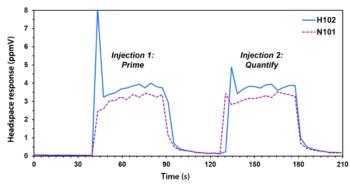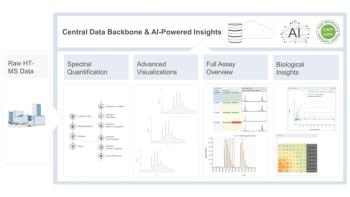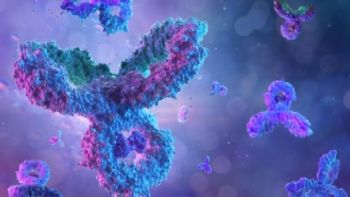
- Current Trends in Mass Spectrometry
- Volume 23
- Issue 1
- Pages: 26–28
Advanced Quantitative Proteomics Using IMS-MS
The benefits of IMS-MS for quantitative proteomics, including enhanced sensitivity, improved selectivity, and reduced interference, are discussed.
Quantitative proteomics is a growing field that faces major challenges: complex sample matrices, wide dynamic ranges of proteins, and the ubiquitous presence of isomers and post-translational modifications (PTMs). Ion mobility spectrometry–mass spectrometry (IMS-MS) is a powerful analytical tool that addresses these challenges by providing an additional dimension of separation based on molecular size, mass, shape, and charge. This article discusses the benefits of IMS-MS for quantitative proteomics, including enhanced sensitivity, improved selectivity, and reduced interference. A case study is presented demonstrating the applications of IMS-MS for quantifying low-abundance peptides in a complex tissue sample in gene therapy development.
The peptide and protein therapeutics market is experiencing significant growth, driven by benefits such as increased targeting precision, the rising prevalence of chronic diseases requiring these treatments, and the advent of personalized medicine, which many believe will transform millions of lives worldwide. As Figure 1 illustrates, the market is projected to double in size by 2033 (1), creating abundant opportunities for pharmaceutical developers.
However, fully capitalizing on this potential is no simple task, and it comes with a host of technical challenges (Figure 2). The advancing boundaries of molecular biology, coupled with the pharmaceutical industry’s urgent need for rapid treatment development, have spurred demand for ever more sophisticated tools to tackle the complex questions that emerge with scientific progress. This article explores how ion mobility spectrometry–mass spectrometry (IMS-MS) is helping researchers address two critical challenges: isomer differentiation and post-translational modifications (PTMs).
Understanding IMS
Three specific dimensions of separation by liquid chromatography–mass spectrometry (LC–MS) have been the cornerstone of pharmaceutical research, enabling detailed analysis of a wide variety of analytes by combining retention time (from liquid chromatography), mass-to-charge ratio (m/z) (from mass spectrometry), and ion intensity. This approach has been highly effective in characterizing compounds based on their mass, size, and charge properties. However, these three dimensions of separation can sometimes be insufficient to fully resolve closely related species such as isomers or conformers, which exhibit similar physicochemical characteristics but have distinct profiles.
In contrast, ion mobility spectrometry when coupled with modern mass spectrometry (IMS-MS) adds an additional dimension of analysis, molecular shape. Thus, IMS-MS can differentiate ions based not only on m/z but also on mobility through a buffer gas, offering insights into molecular shape and structure. This extra layer of separation enhances MS by improving resolution and selectivity and enabling the analysis of complex samples that contain only a few molecules of interest. It is for these reasons that IMS-MS is a particularly powerful tool for proteomics, enabling researchers to distinguish complex molecules such as isomers and analyze subtle structural variations in peptides or proteins (2).
Analytical Challenges Associated with Isomer Differentiation
Isomer differentiation, particularly in complex biological systems, is one of the most significant analytical challenges facing proteomics. Isomers—molecules with the same molecular formula but different arrangements of atoms—can have very similar masses and chemical properties, making them difficult to distinguish using traditional mass spectrometry alone. Such three-dimensional differences can affect biological functions. When drugs are designed to interact with these molecules, they must be able to distinguish between these subtle variations to ensure specificity and efficacy.
A compelling example of this challenge is seen in glycomics, where the stereochemistry and linkage types of sugars—along with their regioisomer variations—play crucial roles in biological signaling. These differences in shape, linkages, and substitutions can drastically influence biological function, with even slight changes in geometry resulting in molecules with vastly different biological activities, such as shifting from benign to pathogenic effects.
Traditional methods often fail to distinguish between isomers with subtle yet crucial functional differences because their mass and chemical properties are nearly identical. In contrast, IMS-MS provides a powerful solution by analyzing ions based on their mobility in a gas phase, which correlates to their molecular size and shape.
By capturing the physical properties of ions in addition to their m/z, IMS-MS enables more accurate profiling of complex molecules, enhancing our understanding of how small structural changes can lead to significant functional differences. This is especially important in fields such as drug design, where identifying and targeting the correct isomer can mean the difference between therapeutic success and failure.
Additional Challenges Caused by PTMs
PTMs, such as phosphorylation, glycosylation, and acetylation, are critical for regulating biological processes. However, these modifications also add significant complexity to proteomics analysis because they introduce structural variations that can alter the function of proteins. Therefore, identifying and accurately quantifying these modifications present key challenges that must be addressed to ensure drug safety and efficacy.
Many traditional techniques exist to detect PTMs; however, these techniques often struggle with high false-positive rates (3). This issue is particularly problematic for glycopeptides (4), which are generated during enzymatic protein hydrolysis. In these cases, structural shape plays a crucial role in distinguishing between different species, as minor differences in glycan structures can lead to significant functional consequences. Without the ability to precisely differentiate these species, there is a risk of misidentifying or misquantifying the peptides, leading to inaccurate conclusions.
Figure 3 illustrates various common PTMs and their typical binding sites on amino acids. Research has shown that incorporating collisional-cross section (CCS) values—essentially a measure of the effective surface area of an ion—into analytical software can significantly reduce false positives (5). This helps refine processing algorithms, improving the accuracy of PTM identification. By using CCS values, researchers can distinguish between closely related PTMs, as the shape of the ion provides additional information that mass spectrometry alone cannot offer.
However, even with these advances, more complex scenarios, such as distinguishing between subtle mutations or resolving isobaric species, require more sophisticated techniques. In challenging biological matrices, where the presence of interfering substances can further complicate analysis, the added selectivity provided by IMS becomes crucial.
To illustrate the practical application of IMS-MS, this article presents a recent case study showcasing how trapped ion-mobility spectrometry (TIMS) was used to tackle the dual challenges of sensitivity and selectivity in the identification and quantitation of specific peptides critical to a gene therapy program.
Methods
This study aimed to identify and quantify four specific peptides at low levels (~20 pg) as part of a gene therapy program. The workflow included enzymatic digestion and advanced sample preparation of digested tissues, which ultimately allowed the detection of 33,000 peptides and the identification of 2900 proteins in the proteomics database. The following optimized IMS-MS workflow was developed using TIMS-quadrupole time-of-flight (QTOF)-MS.
Experimental
The following experimental procedure was performed using TIMS-TOF on preclinical samples for a new gene therapy.
Quantitative Analysis
Stable isotope analogues were used to establish absolute quantitative ratios for the peptides of interest. This enabled precise differentiation between the mutant protein and the corrected protein being expressed.
IMS Analysis Optimization
Ion mobility separation was performed using the TIMS device (Bruker), where the gas flow direction across the ion mobility region was matched with a precisely controlled electric field. This ensured ions remained stable during the separation process, minimizing ion loss and maximizing sensitivity.
Minimizing Fragment Ion Loss
To prevent fragment ion loss during transmission, the TIMS device used a precisely controlled electric field to hold ions stationary against the moving gas. This balance allowed ions to be separated based on their m/z with high efficiency.
Accelerated Accumulation
Ions exiting the mobility separation region passed through an exit funnel to the QTOF-MS analyzer (Bruker). During elution, the voltage on the mobility analyzer was ramped, accumulating mass spectra in fractions of a microsecond. These spectra were correlated with specific ion mobility values.
Sequential Analysis Cycles
After the ion mobility separation region was emptied, a new analysis cycle immediately began. This iterative process maintained high throughput without compromising sensitivity or selectivity.
Results
Visual Representation
Figure 4 illustrates the wide diversity of peptides detected in the tissue sample, underscoring the method’s capability to analyze complex biological samples with wide dynamic ranges while providing the selectivity required to focus on specific targets, with critical implications for genetic syndromes.
Protein and Peptide Detection
From the proteomics database, 33,000 peptides and 2900 proteins were identified in the digested tissue sample. This included the four target peptides of interest, which were successfully detected at low concentration levels (~20 pg).
Sensitivity and Selectivity
The TIMS-QTOF-MS workflow demonstrated enhanced sensitivity without sacrificing selectivity, overcoming challenges related to the wide dynamic range of the sample and the need to resolve subtle amino acid differences caused by mutations.
Conclusion
Resolving complex mutations and structural nuances is a persistent challenge in proteomics and related fields. IMS-MS addresses these challenges by offering high selectivity for isomer differentiation and PTM identification, enabling researchers to accelerate the development of transformative therapies. While this case study highlights the applications of IMS-MS in a “bottom-up” proteomics context, its versatility extends to intact protein analysis, protein-protein interactions, and small molecule detection. TIMS-QTOF-MS further enhances these applications with its ability to concentrate ions and handle wide dynamic ranges.
Beyond proteomics, IMS-MS plays a critical role in emerging areas such as RNA-based drug development, where structural modifications, such as thiophosphate substitutions, affect chirality and pharmacokinetics. IMS-MS also offers valuable insights for small molecule formulation, demonstrating its broad utility in advancing drug discovery and development.
References
(1) Protein Therapeutics Market Size, Share, and Trends 2025 to 2034.
(2) Burnum-Johnson, K.; Xueyun, Z.;Dodds, J.; et al. Ion Mobility Spectrometry and the Omics: Distinguishing Isomers, Molecular Classes and Contaminant Ions in Complex Samples. TrAC 2019, 116, 292–299. DOI: 10.1016/j.trac.2019.04.022
(3) Kim, M.-S.; Zhong, J.; Pandey, A. Common Errors in Mass Spectrometry-based Analysis of Post-translational Modification. Proteomics 2017, 16 (5), 700–714. DOI: 10.1002/pmic.201500355
(4) Piovesana, S.; Cavaliere, C.; Cerrato, A.; et al. Recent Trends in Glycoproteomics by Characterisation of Intact Glycopeptides. Anal. Bioanal. Chem. 2023, 415 (18), 3727–3738.DOI: 10.1007/s00216-023-04592-z
(5) Will, A.; Olin, D.; Bleiholder, C.; Meier, F. Peptide Collision Cross Sections of 22 Post‐translational Modifications. Anal. Bioanal. Chem. 2023, 415 (27), 6633–6645. DOI: 10.1007/s00216-023-04957-4
David Jones is a VP Technical Solutions at Sannova Analytical. He possesses extensive expertise in the fields of drug discovery, development, and cGMP drug manufacturing. He has honed his expertise in bioanalytical techniques for small molecules of varying complexity and is proficient in advanced methodologies, such as high-resolution mass spectrometry for the bioanalysis of large molecules across diverse classes. He has worked closely with Sannova’s CMC team to pioneer analytical approaches for complex formulations. David values collaboration among scientific teams and remains committed to delivering innovative solutions that contribute to the betterment of human health. He is an alumnus of SUNY Stony Brooks University.
Articles in this issue
8 months ago
Current Trends in Mass Spectrometry Europe LinkNewsletter
Join the global community of analytical scientists who trust LCGC for insights on the latest techniques, trends, and expert solutions in chromatography.





